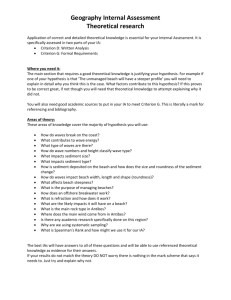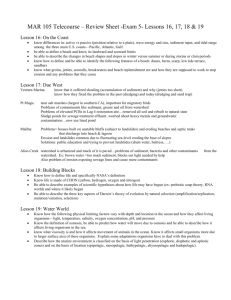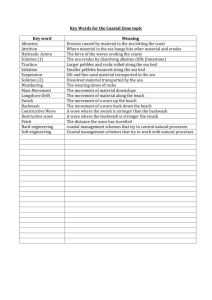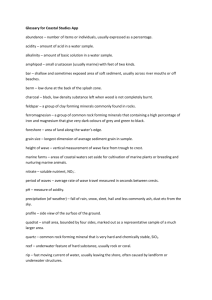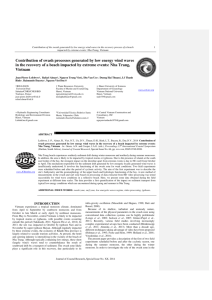Coastal 2 students
advertisement
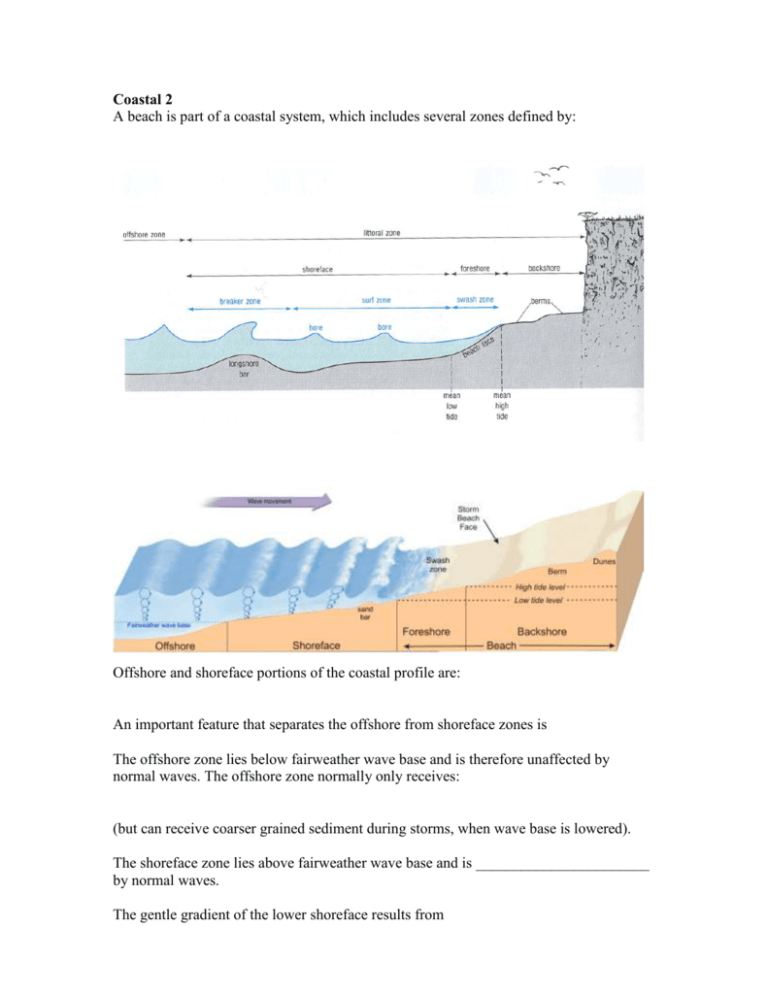
Coastal 2 A beach is part of a coastal system, which includes several zones defined by: Offshore and shoreface portions of the coastal profile are: An important feature that separates the offshore from shoreface zones is The offshore zone lies below fairweather wave base and is therefore unaffected by normal waves. The offshore zone normally only receives: (but can receive coarser grained sediment during storms, when wave base is lowered). The shoreface zone lies above fairweather wave base and is _______________________ by normal waves. The gentle gradient of the lower shoreface results from . Near the top of the shoreface zone, the base of a wave is slowed down due to: The wave is oversteepened, and breaks, losing much of its energy. Due to the loss of energy, some sediment can be deposited in _____________________. Once a wave breaks, its water moves as a sheet upslope as _______________, and falls back toward the sea as ____________________. The narrow area in which this occurs is called the __________________________. The location of swash zone shifts due to the rising and falling of the water level, associated with __________________________. The area affected by the swash zone on a daily basis is called the _________________ (between: ____________________________________________________________) As the flow of swash slows (and eventually stops) in its upper reaches, some of the sediment carried by the water can be _________________________. But much of the sediment is returned back down to the upper shoreface due to backwash. Beyond the Foreshore of some beaches is a ___________________________________, characterized by dunes. Dunes are constructed by _______________________ sediment transported from the foreshore and elsewhere. Sediment can also be transported to the backshore area during storms, when big waves can reach far inland (note that a storm beach face can be seen well away from the normal beach face). Not all shorelines are alike. Whereas some shorelines are dominated by _____________ (as is the case for sandy beaches), others are dominated by _______________________. Shorelines characterized by exposed bedrock and strong wave activity are important suppliers of beach sediment. Minerals of beach sediment derived mostly from eroded rocks along the coast match those of the source rocks. …But most sediment supplied to beaches along continental coastlines is delivered to the coast by _______________________. When a river enters a large body of water (e.g. ocean), its flow rapidly decreases, resulting in: ___________________________________________________________ The resulting sediment deposit is a delta. If wave action is _________________, sediment deposited at a river mouth can be transported along the coastline instead of forming a well-defined delta. How is sediment transported along a coastline ? Most waves move toward the shore at a slight angle. Consequently, the uprush of water (swash) from each breaking wave is oblique. However, the backwash runs back to the water at a right angle. Sediment particles are therefore transported in a: This “beach drift” can carry sand and pebbles hundred to thousands of metres per day. In a similar manner, water in the shoreface zone flows toward the shore at an angle, and flows back at a right angle to the shore. The net result is a current that flows parallel to the shore. This is called a ___________________________. The movement of shoreface sediment by a longshore current is called _______________ Rip Currents: Breaking waves approaching the beach carry water toward the beach. The water can't just pile up there: it has to escape back out to sea somehow. Various “paths of least resistance” (e.g. low areas along sandbars) provide areas for water to flow back to the sea. If caught in a rip current, swim _________________________________________ ! Undertow: Undertow results when water cannot escape as a rip current. Remember that water that is pushed toward the beach must return to the sea somehow. If the water can’t escape as a rip current, it returns to the sea by flowing underneath the waves.

